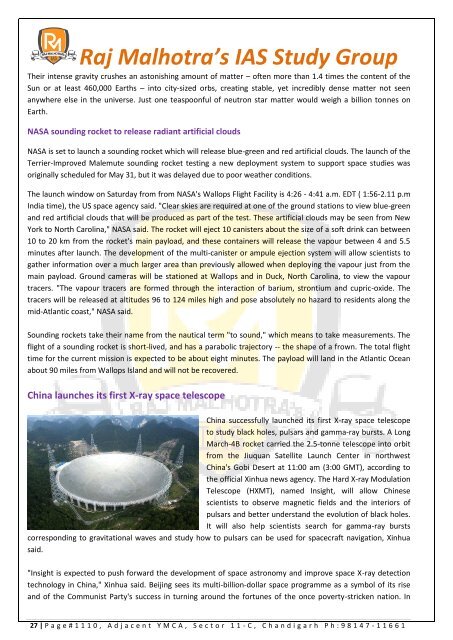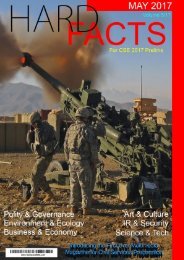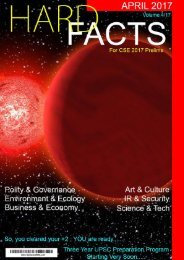You also want an ePaper? Increase the reach of your titles
YUMPU automatically turns print PDFs into web optimized ePapers that Google loves.
Raj Malhotra’s IAS Study Group<br />
Their intense gravity crushes an astonishing amount of matter – often more than 1.4 times the content of the<br />
Sun or at least 460,000 Earths – into city-sized orbs, creating stable, yet incredibly dense matter not seen<br />
anywhere else in the universe. Just one teaspoonful of neutron star matter would weigh a billion tonnes on<br />
Earth.<br />
NASA sounding rocket to release radiant artificial clouds<br />
NASA is set to launch a sounding rocket which will release blue-green and red artificial clouds. The launch of the<br />
Terrier-Improved Malemute sounding rocket testing a new deployment system to support space studies was<br />
originally scheduled for May 31, but it was delayed due to poor weather conditions.<br />
The launch window on Saturday from from NASA's Wallops Flight Facility is 4:26 - 4:41 a.m. EDT ( 1:56-2.11 p.m<br />
India time), the US space agency said. "Clear skies are required at one of the ground stations to view blue-green<br />
and red artificial clouds that will be produced as part of the test. These artificial clouds may be seen from New<br />
York to North Carolina," NASA said. The rocket will eject 10 canisters about the size of a soft drink can between<br />
10 to 20 km from the rocket's main payload, and these containers will release the vapour between 4 and 5.5<br />
minutes after launch. The development of the multi-canister or ampule ejection system will allow scientists to<br />
gather information over a much larger area than previously allowed when deploying the vapour just from the<br />
main payload. Ground cameras will be stationed at Wallops and in Duck, North Carolina, to view the vapour<br />
tracers. "The vapour tracers are formed through the interaction of barium, strontium and cupric-oxide. The<br />
tracers will be released at altitudes 96 to 124 miles high and pose absolutely no hazard to residents along the<br />
mid-Atlantic coast," NASA said.<br />
Sounding rockets take their name from the nautical term "to sound," which means to take measurements. The<br />
flight of a sounding rocket is short-lived, and has a parabolic trajectory -- the shape of a frown. The total flight<br />
time for the current mission is expected to be about eight minutes. The payload will land in the Atlantic Ocean<br />
about 90 miles from Wallops Island and will not be recovered.<br />
China launches its first X-ray space telescope<br />
China successfully launched its first X-ray space telescope<br />
to study black holes, pulsars and gamma-ray bursts. A Long<br />
March-4B rocket carried the 2.5-tonne telescope into orbit<br />
from the Jiuquan Satellite Launch Center in northwest<br />
China's Gobi Desert at 11:00 am (3:00 GMT), according to<br />
the official Xinhua news agency. The Hard X-ray Modulation<br />
Telescope (HXMT), named Insight, will allow Chinese<br />
scientists to observe magnetic fields and the interiors of<br />
pulsars and better understand the evolution of black holes.<br />
It will also help scientists search for gamma-ray bursts<br />
corresponding to gravitational waves and study how to pulsars can be used for spacecraft navigation, Xinhua<br />
said.<br />
"Insight is expected to push forward the development of space astronomy and improve space X-ray detection<br />
technology in China," Xinhua said. Beijing sees its multi-billion-dollar space programme as a symbol of its rise<br />
and of the Communist Party's success in turning around the fortunes of the once poverty-stricken nation. In<br />
27 | P a g e # 1 1 1 0 , A d j a c e n t Y M C A , S e c t o r 1 1 - C , C h a n d i g a r h P h : 9 8 1 4 7 - 1 1 6 6 1





